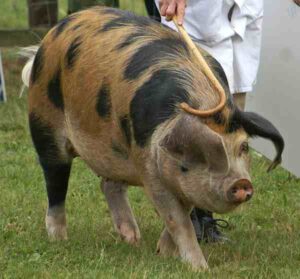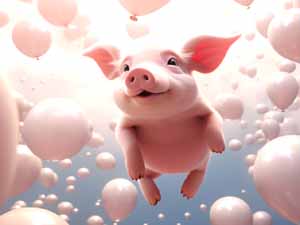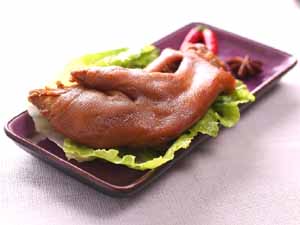Juliana pigs are very beautiful and smaller sized pigs probably originated in Europe through selective breeding of various kinds of mini pigs. It is also known by some other names such as Juliana Mini pigs, Miniature Painted pig, Painted Mini or Mixed Breed. They are very small and colorfully spotted pig. Juliana pigs closely resembles a small version of a large hog or feral pig. They are social and very friendly animals, and they are excellent choice for raising as pets.
Origin and history of Juliana pigs
The Juliana pigs were originated from a combination of various smaller sized pig breeds (probably the Vietnamese pot-bellied pig and German miniature pigs were used). The breed’s development began in the mid-20th century. The main aim of the breeders was creating a miniature pig that retain the desirable traits of standard pigs but on a much smaller scale. After development, the breed had gained recognition for it’s petite size, and their endearing, social nature. Today Juliana pigs are popular for raising as companion animals. They are popular mainly for their playful personalities and relatively smaller size.

Characteristics
The Juliana pigs are small and colorfully spotted pigs. They have a lean and muscular body. Their head is well shaped, and the most prominent feature of the head is a long straight snout that is neither turned up nor snubbed. Their ears are smaller and erect, and the eyes are almond shaped, clearly visible, and can be blue to almost black in coloration. The tail of the Juliana pig is straight when relaxed with a switch on the end. The tail may be curl or twist when the animal become excited or in motion.
Legs of the Juliana pigs are well apart, and straight when viewed from the front and rear. Their feet are strong, closed, even and forward facing. They are always spotted and their base color can be silver, white, red, rust, black or cream. Spots are generally black, but sometimes can also be red or white. Hair coat is coarse, thick and may be quite long in the winter. Fully grown Juliana pigs are between 10 and 16 inches tall and 14 to 20 inches long. And average body weight of the mature pigs is between 40 and 60 pounds.
Dietary requirements
Like all other pig breeds, the Juliana pigs also have specific dietary requirements to ensure their good health. You can provide them commercially prepared pig feed which are especially formulated for the miniature pigs. Commercial feeds are designed to provide essential nutrients, vitamins and minerals in balanced proportions. You can also provide your pigs with fresh vegetables and fruits such as carrots, bell peppers, taro, spinach, kale, pears, apples, berries etc. Avoid feeding them high-sugar fruits or starchy vegetables like potatoes. Avoid feeding them some human foods like chocolate, sweets, processed snacks, onions, garlic and avocados. And always ensure access to enough clean and fresh drinking water as per their demand.
Housing requirements
The Juliana pigs are smaller in size, so their housing requirements are relatively less. Provide them adequate space to move around and exercise. Try to arrange at least 16-24 square feet housing space per animal, but larger areas are better. Make their flooring non-slippery and easy to clean by using rubber mats or tiles. Provide soft bedding inside their house to keep them comfortable. You can use straw, hay or specialized Juliana pig bedding. Ensure good ventilation system inside their house and maintain good hygiene.
Reproduction
The Juliana pigs are excellent breeders. They are not seasonal breeders and they can breed year-round. They generally reach maturity within their 5-7 months of age. Although we recommend to wait until they reach at least 1 year old before breeding. After successful mating the sows become pregnant and their approximate gestation period is 114 days. Farrowing generally occurs without any complications and the sow generally deliver the piglets with minimal assistance. You can expect between 4-12 piglets per litter. Take good care of the piglets and their mother.
Caring
Taking good care of the Juliana pigs is very important for their good health and good growth. Always provide them with enough nutritious food, provide them comfortable housing system and provide enough health care. Vaccinate them timely and contact a vet if you notice any problem.
Lifespan
Average lifespan of the Juliana pigs is between 12 and 15 years. But they can live even longer if you can take good care of them.
Uses
The Juliana pigs are mainly used as a companion animal due to their affectionate and playful personalities. Their smaller size makes them ideal for indoor living. They are also often used as therapy animals, in educational programs to teach about animal care.
Frequently Asked Questions
How big do Juliana pigs get?
Juliana is a smaller sized pig breed. Fully grown Juliana pigs are between 10 and 16 inches tall and 14 to 20 inches long. And average body weight of the mature pigs is between 40 and 60 pounds.
What are Juliana pigs good for?
The Juliana pigs are good for raising as pets, mainly for their smaller size and friendly nature.
How long do Juliana pigs live?
Average lifespan of the Juliana pigs is between 12 to 15 years.
Can you eat Juliana pigs?
The Juliana pigs are generally not raised for meat. They are mainly raised as companion animals. They are edible, but it’s not recommend to use them as food. Ethical considerations and the focus on their role as pets generally outweigh any practical use for meat.
Are Juliana pigs good for meat?
No, they are not good for meat production like other large pig breeds. Rather, they are raised mainly as companion animals.
What can Juliana pigs not eat?
Avoid feeding your Juliana pigs high-sugar fruits or starchy vegetables like potatoes, chocolate, sweets, processed snacks, onions, garlic and avocados.
Can Juliana pigs stay outside?
Yes, your Juliana can stay outside if you live in a mild climate. Provide them a warm shelter if you want to keep your pigs outside.
Can Juliana pigs eat eggs?
Yes, they can eat eggs occasionally. They can even eat raw eggs occasionally. But don’t give them raw eggs in large volumes, because doing this can result in a biotin deficiency. So, give them eggs in moderation.






